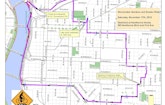
Interested in Education/Training?
Get Education/Training articles, news and videos right in your inbox! Sign up now.
Education/Training + Get AlertsWith a big share of their city served by combined sewers that carry both wastewater and stormwater runoff, Portland, Ore., officials have worked for more than 20 years to greatly reduce the occurrences of overflows triggered by heavy rains.
The city launched a 20-year program of construction, redesign and education to reduce overflows into the Willamette River and the Columbia Slough as required by the Oregon Department of Environmental Quality. When the project began in 1991, the city averaged more than 50 overflow incidents per year resulting in the release of combined stormwater and raw sewage into the rivers running through the city. By the time the final major work in the program was completed in 2011, the city was projected to have one overflow per summer and four overflows during the rainy winter season.
Ironically, the most recent overflow occurred a day after Portland’s Bureau of Transportation dedicated its Autumn Portland By Cycle event to a tour of swales and rain gardens installed around the city to keep rainwater out of the combined sewer system.
Ivy Dunlap, a landscape architect with the Portland Bureau of Environmental Services joined tour leader Timo Forsberg, an alternative transportation specialist, to lead the Saturday afternoon tour. Dunlap says the ride was one of many that have been used to help educate people about the city’s stormwater projects.
The city’s news release announcing the 6.5-mile tour of stormwater gardens and swales said the timing was good because the weather forecast called for rain, meaning the riders could see the structures in action. But on Saturday morning it looked like there might be too much of a good thing.
“The rain was coming down in sheets in the morning, so I can imagine some people who planned to take the tour might have been deterred,” Dunlap says. By the time the ride began, however, the storm had abated and there was just a gentle rainfall. Dunlap says about a dozen riders showed up for the tour that took them around the city to observe a variety of public and private stormwater installations.
The swales redirect and slow runoff, giving surface water more time to absorb into the ground while the gardens capture water in structures, allowing it to be absorbed, as well.
Included on the tour route were several of Portland’s Green Streets where rain gardens, curb designs, tree planting and other steps are used to deter water from entering the sewers.
The Green Streets program is just one of many steps the city used in its 20-year program to reduce combined sewer overflows. The program also included the construction of three massive underground pipelines to temporarily store excess water during rain events. The most recent and largest tunnel project was the Eastside Big Pipe, a six-mile-long, 22-foot-diameter pipeline buried 100 feet underground. The pipe went into service in 2011.
Other key steps in the program included the construction of separate sewers in key runoff areas, a program to encourage more than 50,000 private property owners to disconnect downspouts directly connected to the combined sewers and the use of sumps to divert excess stormwater from the system before it mixes with wastewater.
Dunlap says the tours are geared to teach and encourage Portland residents to get involved in reducing stormwater runoff. They also help develop support for the city’s investment in environment efforts. “A big part of this is outreach and education about what we do,” she says. “If they know more, they appreciate it more.”
Of course, in a city where environmentalism is popular, a hard sell is not always necessary.
“We had one person on a ride who had recently adopted six or seven Green Street installations to maintain in his neighborhood,” says Dunlap. “He lives in a condo and doesn’t have any land, so this is his form of yard work and gardening.”
For more information on the Portland stormwater reduction program see:
www.portlandonline.com/bes/index.cfm?a=316721&c=31030
www.portlandonline.com/bes/index.cfm?c=31030&a=405547







